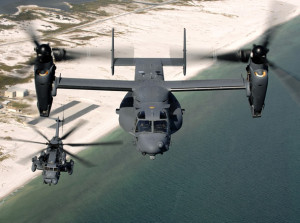

The US Department of Defense released details about the proposed sale of six V-22B Block C Osprey Tilt-Rotor Aircraft to Israel. Notifying the planned planned Foreign Military Sale to the US congress, the Defense Security Cooperation Agency said the estimated cost of the package, that includes six aircraft, associated equipment, parts, training and logistical support could cost up to $1.13 billion. The six aircraft are expected to be fielded with the Israel Air Force (IAF) by 2016. The IAF is planning to operate the new aircraft as part of a composite squadron operating both Sikorsky CH-53 (Yasour 2000/2025) and Bell/Boeing MV-22.
The V-22 can carry 24 fully equipped troops or up to nine tons of cargo (using short take off run) over a radius of about 390 nautical miles (700 km), at a cruising speed of about 241 knots (440 km/h). The CH-53 can carry more troops (38) or up to five tons of cargo, on missions ranging to 90 nautical miles (160 km). Both can extend mission range by aerial refuelling. The IAF operates 23 CH-53 helicopters, comprising 18 Yasour 2000 and five modernized Yasour 2025 variants. The Air Force plans to maintain these helicopters in service at least through 2025.
The MV-22B Block C is the current (enhanced) variant delivered to the US Marine Corps. This variant features several modifications improving the aircraft reliability, and improving environmental control (air conditioning) in the cabin. The Osprey’s Color Weather Radar system enhances situational awareness with better weather assessment, including precipitation intensity and storm cell turbulence. In addition to weather display the radar can clearly define terrain features along coastlines out to 20 nautical miles in the ground mapping mode. In the sea search mode the radar can also detect ships.
The pilots use helmet-mounted monocle Day Heads-up Display (HUD) to view basic flight and performance data. The Day HUD enhances the pilot’s situational awareness during tactical situations and reduced visibility conditions. At night the HUD is mounted on the Aviator Night Goggles (AVS-9) extending the pilot’s situational awareness during night operations. In the future the display will feature an embedded system is Traffic Advisory System (TAS) – intended to warn MV-22 pilots of other aircraft in close proximity or with the potential for collision. Other changes in the new model include the improvement of cabin air conditioning and installation of ‘Cabin Situational Awareness Device’, enabling troop commanders in the cabin to communicate with the troops, providing flight plan, navigation waypoints and GPS updates to handheld navigation units prior to disembarkation.
According to the DSCA the package the Israeli government has requested includes six aircraft and 16 Rolls Royce AE1107C engines – 12 mounted and four spares. The Bell-Boeing team is hopeful the Israeli buy will be further increased to 12 V-22 aircraft, provided the Corps will exercise options for additional 22 aircraft included in the current contract (Flight Global).
In addition to the standard Block C avionics each of the aircraft destined to Israel will also be fitted with Government Furnished Equipment (GFE) including Electronic Countermeasures (ECM) kit (AN/APR-39 Radar Warning Receiver Systems, AN/ALE-47 Countermeasure Dispenser Systems and AN/AAR-47 Missile Warning Systems). Other avionics included are AN/APX-123 Identification Friend or Foe (IFF) Systems, AN/ARN-153 Tactical Airborne Navigation Systems, AN/ARN-147 Very High Frequency (VHF) Omni-directional Range (VOR) Instrument Landing System (ILS) Beacon Navigation Systems, AN/APN-194 Radar Altimeters, and AN/ASN-163 Miniature Airborne Global Positioning System (GPS) Receivers (MAGR). The aircraft will also carry a Multi-Band Radios supporting air-air and air-ground communications. The package also includes six AN/AVS-9 Night Vision Goggles per plane, and a Joint Mission Planning System.



















